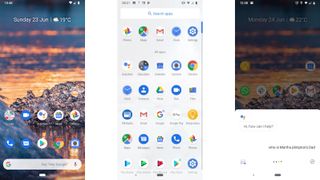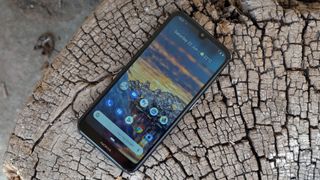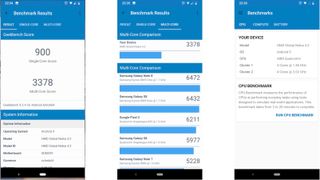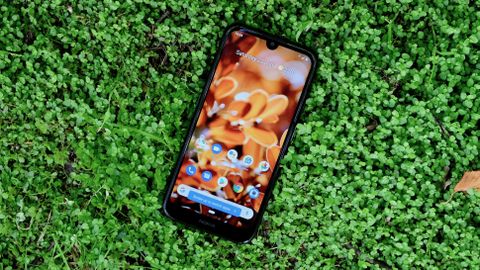Why you can trust TechRadar
Interface and reliability
- Android 9 Pie + stock Google apps = bliss
- Android One means several years of guaranteed updates
One of the key selling points with any modern Nokia phone is the relatively unadulterated version of Android that comes as part of the package. The Nokia 4.2, like the Nokia 9 PureView and the Nokia 3.2 before it, ships with Android One.
This is essentially Android 9 Pie as Google intended it, without the ill-judged tweaks and modifications of Huawei’s EMUI or Xiaomi’s MIUI. This does mean that you get Google’s slightly ropey gesture-based interface, however.
Swiping up from the home button to get the app drawer feels like an overly deliberate manoeuvre, as a quick swipe up will pull you into the app switching/multitasking menu. Swiping right along the bottom will skip you to the previous app.
You’ll get used to it, but you get the feeling that this system isn’t quite where Google wants it to be right now.

Blissfully, Android One means you get Google’s stock apps as standard. That means there are no unnecessary duplicates for email or music, and you get Google’s own Files and Clock apps rather than a pointless and ugly equivalent.
Because all of these are made by Google, they largely match the look and feel of the Android OS itself, which gives everything an appealingly cohesive feel. And yes, the Nokia 4.2 feels a bit more like a flagship phone as a result.
Just as importantly, the presence of Android One means guaranteed updates for two years and security updates for three. That’s priceless in an Android field that often hangs its users out to dry on the legacy support front.
Nevertheless, Android 9 Pie on the Nokia 4.2 doesn’t quite sing as much as we’d like it to. While it’s not unusable, there’s a sense of sluggishness to the general navigation experience that leaves you in no doubt that this is a cheap phone.
Movies, music and gaming
- Weak screen and processor aren't great for media
- 32GB storage with microSD slot
Unfortunately, the Nokia 4.2 isn’t a particularly great media player. It’s a simple case of the hardware not quite being up to the task.
Take that 5.71-inch display, for instance. It’s plenty big enough, and the 19:9 aspect ratio suits modern widescreen content (if you can stand the notch). But its HD+ resolution means that you won’t be able to stream Full HD video from Netflix, Amazon and YouTube.
We’ve also noted that the Nokia 4.2’s screen doesn’t exactly pop with vibrant colour, and it doesn’t get super-bright in outdoor conditions either.

Then there’s the phone’s underwhelming performance. The Snapdragon 439 is perfectly adequate as an entry-level processor, and 3GB of RAM is an acceptable minimum. But your favourite games are hardly going to fly.
Guns of Boom runs okay on the phone. While it’s a famously scalable game, that’s far from a given. It runs terribly on the Alcatel 1X, for example.
But the more demanding PUBG Mobile defaults to Low settings, and doesn’t perform anything above adequately. There are frequent hitches and glitches along the way.

Surprisingly, while Asphalt 9 defaults to the lowest settings, it’s not a complete write-off when you crank things to High. Perhaps we can thank the Nokia 4.2’s less demanding 720p display for that.
On the plus side, 32GB is a decent amount of storage for a cheap phone, and you also get a microSD slot for expansion purposes.
Specs and benchmark performance
- Snapdragon 439 chipset, 3GB RAM
- Benchmarks well below the Moto G7 family
The Nokia 4.2 packs a Snapdragon 439 CPU, and while it does an adequate job of running everything (including, as we’ve just discussed, games), it never quite feels like it’s got a full handle on things.
General performance feels ever so slightly wallowy, with minor but frequent pauses when doing simple things like scrolling through a bunch of Google search results or jumping between apps. Those apps, meanwhile, can often seem to take an age to boot up in the first place.
The real trouble here is the alternatives. There are phones out there that offer flat out good performance for less than £200. The Xiaomi Redmi Note 7 packs the significantly more capable Snapdragon 660, while the Moto G7 Play and Moto G7 Power have the Snapdragon 632.

In each case general performance is frequently indistinguishable from much more expensive phones (at least to the layman), while Xiaomi’s Snapdragon 660-powered phones (the Mi A2 included) can even run high-end games at full tilt.
The difference is laid bare by some simple Geekbench 4 benchmark tests. With the Nokia 4.2, we got an average multicore score of 3338 and a single core score of 895. In tests with the Moto G7 Power, meanwhile, we got a multi-core score of 4440 and a single-core CPU score of 1247.
With 3GB of RAM backing it up, the Nokia 4.2 isn’t a total performance write-off. But it certainly doesn’t feel like the “mini flagship” that Nokia claims it is.
Current page: Anything else I should know?
Prev Page Battery life and camera Next Page Verdict and competition
